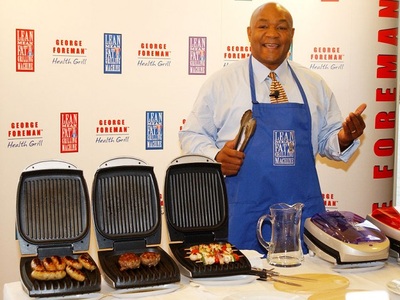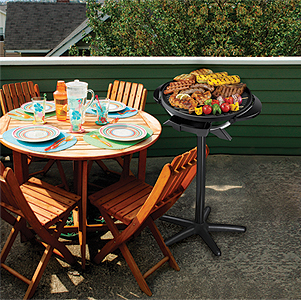|
With over a 100 million sold, it can be said that over 30% of the United States or 1.5% of the world has owned a George Foreman Grill (GFG). Personally I don't think I know a single person who hasn't owned or used one. George Foreman made grilling accessible, all the while coercing folks into believing its healthier and cleaner. However if you've ever owned a GFG you know what a pain in the ass it is to clean. Sure the grease is contained in a little corn-cob holder, but besides washing the container, you have to scrub hot grill surfaces. Then after several uses you'll wonder if the damn thing causes cancer, from the chipped Teflon to the Hetercyclic Amines (HCAs) and Polycyclic Aromatic Hydrocarbons (PAHs) found in grilled meat.
George Foreman is a two-time World Heavy Weight Champion, Olympic gold medalists, and has only lost 5 of his 81 fights. His most poignant loss went to Muhammad Ali in the 1974 Rumble in the Jungle. Besides boxing, Foreman is a husband (married 4 other times), a father of twelve, an author, philanthropist, ordained Christian minister, and entrepreneur. After a religious epiphany in the 80's, Foreman went on to become a minister and reenter the boxing world in 1994. This comeback allowed him to defend his heavy weight title, where following the fight Foreman was approached by the manufacturing company Spectrum and inventors Michael Boehm and Robert Johnson to promote a lean-mean grilling machine. Foreman was known for consuming two low-fat burgers before each match, which ignited his influential product endorsements. In the beginning, Foreman received 40% of the profits from every GFG sold, profiting to a $4.5 million a month in payouts, and obviously couldn't go on forever. So following the GFGs success, Foreman sold the rights to his name for $137 million dollars in 1999. Nevertheless, its plausible this money went quick especially with four ex-wives, and twelve children. Which is why the GFG is an ever evolving piece of furniture, with newer designs and accessories. For instance newer models now have Blue Tooth so you can play your iPod and music through your iGrill, along with an extension cord allowing your electric grill to go outside. What's next the Electric Beard Trimmer Grill, Sonicare Electric Toothbrush Grill, Inflatable Electric Air-Mattress Grill, or the Macbook-Grill?
0 Comments
Leave a Reply. |
LAJ
100 Objects of Popular and Material Culture is an blog exploring the manifestations of human consumption and commodity-ization. The purpose of this experiment is to explore material and popular culture in contemporary society by using objects and concepts to prompt wider questions and reflections. So by emulating The British Museum's and Neil MacGregor's format of A History of the World in 100 Objects I plan to satirically analyze and reinterpreted 100 material culture objects over the course of 2014. Material Culture is the study of our culture's consumption of stuff; namely the manifestation of culture through material productions where people's perceptions of objects is socially and culturally dependent. With this, objects reflect conscious and unconscious beliefs on the the individuals who fabricated, purchased, or used them, and by extension the society where they live. So examining materiality, cultural truths and societal assumptions may be discovered. As anthropologist Arjun Appaduai states "in any society the individual is often caught between the cultural structure of commodity-ization and his own personal attempts to bring a value and order to the universe of things." Objects and commodities make up a much larger symbolic system consisting of want and need, socio-economic status, fashion, etc. Often times form follows function whether the commodity, market, and or consumer forever evolve around one-another. Philosopher Pierre Bourdieu's theories of capital flow full circle; where regardless if you are a minimalist or a hoarder the world is made up of things and everyone will leave their footprint on the earth. So by humorously analyzing marketed objects and concepts, hopefully this blog will provide further incite into ideas of over-consumption, a disposable society, consumerism vs. anti-consumers, planned obsolescence vs. sustainability, as well as the greater good of mankind and future generations. Archives
March 2015
Categories |








 RSS Feed
RSS Feed